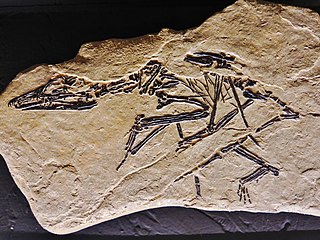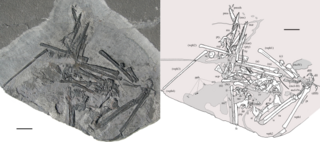
Tanystropheus is an extinct genus of archosauromorph reptile which lived during the Triassic Period in Europe, Asia, and North America. It is recognisable by its extremely elongated neck, longer than the torso and tail combined. The neck was composed of 13 vertebrae strengthened by extensive cervical ribs. Tanystropheus is one of the most well-described non-archosauriform archosauromorphs, known from numerous fossils, including nearly complete skeletons. Some species within the genus may have reached a total length of 6 meters (20 ft), making Tanystropheus the longest non-archosauriform archosauromorph as well. Tanystropheus is the namesake of the family Tanystropheidae, a clade collecting many long-necked Triassic archosauromorphs previously described as "protorosaurs" or "prolacertiforms".

Eudimorphodon was a pterosaur that was discovered in 1973 by Mario Pandolfi in the town of Cene, Italy and described the same year by Rocco Zambelli. The nearly complete skeleton was retrieved from shale deposited during the Late Triassic, making Eudimorphodon one of the oldest pterosaurs known. It had a wingspan of about 100 centimeters (3.3 ft) and at the end of its long bony tail may have been a diamond-shaped flap like in the later Rhamphorhynchus. If so, the flap may have helped it steer while maneuvering in the air. Eudimorphodon is known from several skeletons, including juvenile specimens.

Cearadactylus is a genus of large anhanguerid pterodactyloid pterosaur from the Romualdo Formation of Brazil, South America. Fossil remains of Cearadactylus dated back to the Albian stage of the Early Cretaceous period, about 112 million years ago. The only known species is C. atrox, described and named in 1985 by Giuseppe Leonardi and Guido Borgomanero. The name refers to the Brazilian state Ceará, and combines this with Greek daktylos, "finger", a reference to the wing finger of pterosaurs. The Latin atrox means "frightful", a reference to the fearsome dentition of the species.

Preondactylus is a genus of long-tailed pterosaurs from the Late Triassic that inhabited what is now Italy. It contains a single known species, Preondactylus buffarinii, which was discovered by Nando Buffarini in 1982 at the Forni Dolostone near Udine in the Preone valley of the Italian Alps.

Peteinosaurus was a prehistoric genus of pterosaur. It lived in the late Triassic period in the late Norian age, and at a wingspan of around 60 cm (24 in), was one of the smallest and earliest pterosaurs, although other estimates suggest a wingspan of up to 1 m (3.3 ft).

Austriadactylus is a genus of primitive pterosaur. The fossil remains were unearthed in Late Triassic rocks of Austria.

Raeticodactylus is a genus of non-pterodactyloid pterosaur from the late Norian-early Rhaetian-age Upper Triassic lower Kössen Formation of the central Austroalpine of Grisons, Switzerland. It is known from holotype BNM 14524, a single disarticulated partial skeleton including an almost complete skull, found in August 2005. This genus was named and described in 2008 by its discoverer Rico Stecher; the type species is Raeticodactylus filisurensis. The specific name refers to Filisur.

Carniadactylus is a genus of pterosaur which existed in Europe during the Late Triassic period. The genus contains a single species, Carniadactylus rosenfeldi.

Eopterosauria is a proposed clade of basal pterosaurs from the Triassic. The term was first used in Andres et al. (2014) to include Preondactylus, Austriadactylus, Peteinosaurus and Eudimorphodontidae. Inside the group were two other new clades, Preondactylia, which included Preondactylus and Austriadactylus, and Eudimorphodontoidea, to include Eudimorphodontidae and Raeticodactylidae. Eopterosauria was defined as "the least inclusive clade containing Preondactylus buffarinii and Eudimorphodon ranzii". The specimen BSP 1994, previously assigned to Eudimorphodon, was named the separate taxon Austriadraco in 2015, and assigned to the new family Austriadraconidae, but further classification was not described. The following phylogenetic analysis follows the topology of Andres et al. (2014).

Eudimorphodontidae is an extinct family of early pterosaurs from the Late Triassic of Europe. It was named by Peter Wellnhofer in 1978 to include Eudimorphodon ranzii. Some phylogenetic analyses suggested that Eudimorphodontidae is a junior synonym of Campylognathoididae, however more comprehensive analyses found Eudimorphodontidae to be basal to Macronychoptera that includes Campylognathoididae and more derived pterosaurs (Breviquartossa). Wang et al. (2009) found Eudimorphodontidae to include six species, but they didn't defined the clade. Brian Andres define Eudimorphodontidae and found Peteinosaurus to be most closely related to it. Furthermore, he found monophyletic Eudimorphodon clade, and defined two subfamilies within Eudimorphodontidae. The Eudimorphodontinae includes all taxa more closely related to Eudimorphodon ranzii than to Raeticodactylus filisurensis while the Raeticodactylinae includes all taxa more closely related to Raeticodactylus filisurensis than to Eudimorphodon ranzii. More recently, Raeticodactylus and Caviramus were moved into their own family, Raeticodactylidae. The below cladogram follows that analysis.
Arcticodactylus is a genus of basal pterosaur living during the Late Triassic in the area of present Greenland. Its only species was previously attributed to Eudimorphodon, and its closest relatives may have been Eudimorphodon or Austriadraco.
Austriadraco is a genus of pterosaur living during the Late Triassic in the area of present Austria. Its only species—Austriadraco dallavecchiai—was previously attributed to Eudimorphodon, and its closest relatives may have been Eudimorphodon or Arcticodactylus.

Bergamodactylus is a putative genus of basal pterosaur which lived during the Late Triassic in the area of present-day Bergamo province in Italy. Its only species is Bergamodactylus wildi. It was named in 2015 based on a pterosaur specimen which had previously been regarded as a juvenile Eudimorphodon or as identical to Carniadactylus. Some Triassic pterosaur specialists consider the distinguishing features of Bergamodactylus to be invalid or insufficient to distinguish it from Carniadactylus, and thus retain the specimen in that genus.
Raeticodactylidae is a family of eudimorphodontoid eopterosaurian pterosaurs that lived in Switzerland during the Late Triassic. The family includes Caviramus, and the type genus Raeticodactylus, which are both known from the Kössen Formation, around 205 mya. Raeticodactylidae was first used in 2014 by Andres et al., as a group of all pterosaurs closer to Raeticodactylus than Eudimorphodon. The following phylogenetic analysis follows the topology of Andres et al. (2014).

Caelestiventus is a pterosaur genus from the Late Triassic found in western North America. The type species, Caelestiventus hanseni, honors Robin Hansen, the Bureau of Land Management geologist (BLM), who facilitated access to the excavation site.

Seazzadactylus is a basal pterosaur genus that lived during the late Triassic in the area of present Italy.

Ferrodraco is an extinct genus of anhanguerid pterosaur known from the Late Cretaceous Winton Formation of Queensland, Australia, containing the single species F. lentoni. The species was named after the former mayor of Winton, Graham Thomas ‘Butch’ Lenton. It is the most complete pterosaur fossil from Australia, being known from the holotype specimen AODF 876, consisting primarily of the anterior portion of the skull and dentary, cervical vertebral centra and a partial wing. Its wingspan was estimated to be about 4 meters (13 ft). Ferrodraco was found to have been within the subfamily Ornithocheirinae, as sister taxon to Mythunga. A recent study also recovered Ferrodraco as sister taxon to Mythunga, but both placed within the family Anhangueridae, more specifically within the subfamily Tropeognathinae. Ferrodraco is also the latest surviving member of Anhangueria.
Vetusodon is an extinct genus of cynodonts belonging to the clade Epicynodontia. It contains one species, Vetusodon elikhulu, which is known from four specimens found in the Late Permian Daptocephalus Assemblage Zone of South Africa. With a skull length of about 18 centimetres (7.1 in), Vetusodon is the largest known cynodont from the Permian. Through convergent evolution, it possessed several unusual features reminiscent of the contemporary therocephalian Moschorhinus, including broad, robust jaws, large incisors and canines, and small, single-cusped postcanine teeth.
Pachagnathus is an extinct genus of non-pterodactyloid pterosaur from the late Norian–early Rhaetian-aged Quebrada del Barro Formation of Argentina. It lived in the Late Triassic period, and is one of the only known definitive Triassic pterosaurs from the southern hemisphere. It is also one of the few known continental Triassic pterosaurs, indicating that the absence of early pterosaurs in both the southern hemisphere and terrestrial environments is likely a sampling bias, and not a true absence.
Yelaphomte is an extinct genus of non-pterodactyloid pterosaur from the late Norian–early Rhaetian-aged Quebrada del Barro Formation of Argentina. It lived in the Late Triassic period, and is one of the only known definitive Triassic pterosaurs from the southern hemisphere. It was a small and crested pterosaur, although its small size may be due to immaturity. It is also one of the few known continental Triassic pterosaurs, indicating that the absence of early pterosaurs in both the southern hemisphere and terrestrial environments is likely a sampling bias, and not a true absence.


























